No structure is built without construction joints. Concrete construction joints are inevitable because we cannot finish the work in one go. Depending on the type of structural elements, vertical and horizontal construction joints are provided for in the different phases of construction.
The number of construction joints depends on several factors, such as availability of resources, time required to complete concreting, maximum possible concrete input, type of structure, thermal contractions, etc.
Vertical construction joints are often used in construction and horizontal construction joints are used in many elements. It is also generally recommended to avoid horizontal construction joints as much as possible. However, there are cases where horizontal construction joints cannot be avoided. For example, when building a concrete wall, we cannot avoid construction joints directly above the base.
Let's discuss the advantage of construction joints in concrete structures.
Benefits
- When creating construction joints in concrete, the area that can be concreted at one time is limited. For example, if a large area needs to be concreted, we divide the area into several castings. This speeds up the works because, once partially completed, the concrete works can continue.
- Furthermore, a large area cannot be concreted in one day. It would take a long time and could require a huge amount of concrete. Therefore, the size of the concreting work can be selected depending on the capacity of the concrete batching plants and the contractor's human resources.
- When constructing thick concrete, additional stresses are created in the concrete due to thermal contractions. For a thick foundation, such as slab foundations, the concrete can be poured in multiple pouring stages to avoid this problem with the supports.
Disadvantages
- Construction joints in water-retaining structures always pose a certain risk to their usability. There is a higher chance of water leaking through the construction joint. We have to provide joint barriers as a solution, which adds costs to the project.
- All construction joints must be properly prepared before the next concreting. Furthermore, additional reinforcements must be provided for joints of this type.
Beam construction joints
When beams are manufactured in two distinct phases, construction joints must be provided. The type of construction joint depends on the span, load, location of the joint, etc.
For smaller beams that transmit lower bending and shear forces, the general connection can be provided without much detail. However, much attention needs to be paid to beams that support heavier loads.
Where should beam construction joints be provided?
In general, the bending moment of the beam becomes almost zero at one-third of the span. Furthermore, as the connection in the beam is vertical, it is advisable to place it where the bending moment is lowest.
Furthermore, the shear force of the beam also decreases as the span increases. Therefore, we generally provide construction joints for approximately one-third of the span.
However, depending on site conditions and the civil engineer's recommendations, the final position and arrangement of the joint may be changed.
Beam construction joint detail
No construction joints are maintained for cantilever beams. The details shown below can be used for construction.


Fixing dowels is not absolutely necessary, especially for smaller beams. Furthermore, the construction joint must be sufficiently sawed before the second casting.
Slab Construction Joint
Construction joints are held in place as described above to improve constructability. Depending on panel usage and structural requirements, appropriate construction details are provided.
There are essentially two types of panels: panels for normal buildings and panels for water storage structures.
When using a water tank, a joint barrier must also be provided for the construction joint to prevent water from escaping through the construction joint.
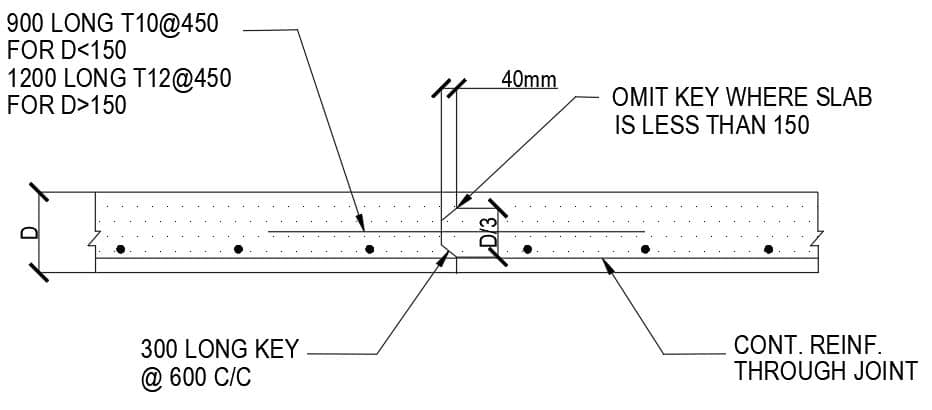
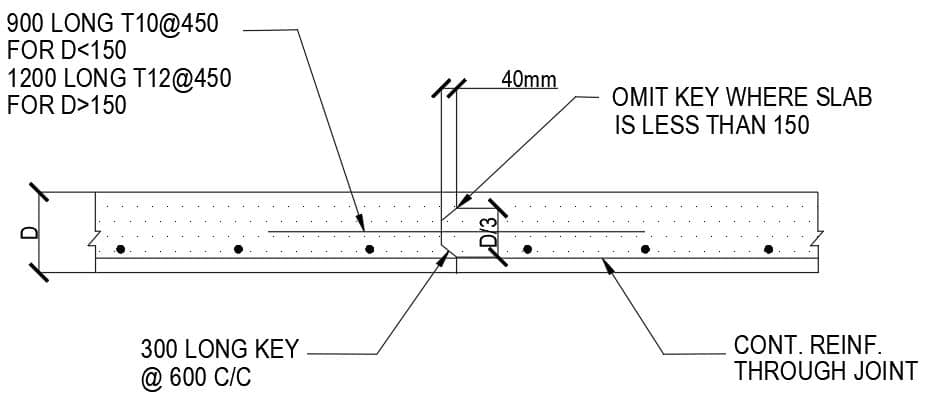
During construction, it is not essential to follow the details above. Sometimes a spalling concrete surface is also considered based on the spans and applied loads.
Additionally, wooden boards are attached to the side formwork in the form of shear wedges for construction joints. These wedges can be fixed at a distance of 600 mm.
Column Construction Joints
Horizontal construction joints must always meet structural requirements. They can be at ground level and directly below the beam. These two joints cannot be avoided.
Depending on resource availability and other construction practices, additional construction joints may exist in concrete piers.
When concrete is poured into concrete columns, a soft layer of soil forms on the surface of the finished concrete. This must be removed before placing new concrete.
Most of the time it can be seen that the pillars are not chipped enough to remove the upper layer of weak concrete, which does not have enough strength. This can be seen as a design flaw and type of column flaw .
Wall Construction Joint
A construction joint directly above the base/foundation could not be avoided. Additionally, a joint barrier could be provided if the wall is designed to retain water.
Additionally, it may be necessary to attach joint tapes to construction joints if watertightness is required.
If there is a joint barrier at the wall construction joint, it can be routed through the base, but is not required. If the construction joint passes through the base, as in the water tank, the joint barrier must also pass through the base.
Construction joints in large retaining walls
If the dimensions of the retaining walls become significantly larger, it is generally not possible to provide a construction joint with shear teeth. Providing shear teeth would not be sufficient and stress concentrations would occur along this joint.
When planning larger retaining walls or structures with very high transverse loads, a special inspection of the construction joints must be carried out. High shear force is applied to the horizontal construction joints at the lower level. Concrete friction is the main factor that limits movement. Since we know the cohesion of the concrete and the surface area of the joint, we can calculate the resistance force. This way we can check the stability.
For the reasons mentioned above and many others, multiple shear wedges are provided along the cross sections.
Especially for longer retaining walls, concrete cannot be poured all at once. Therefore, concrete is poured in several stages. A construction joint is provided at the connection points between the casting steps. The following sketch shows the arrangement of these construction joints.
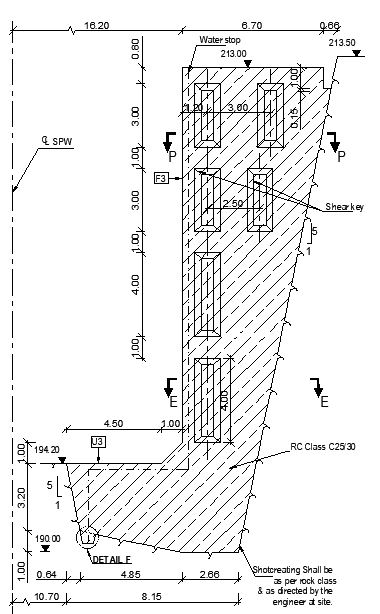
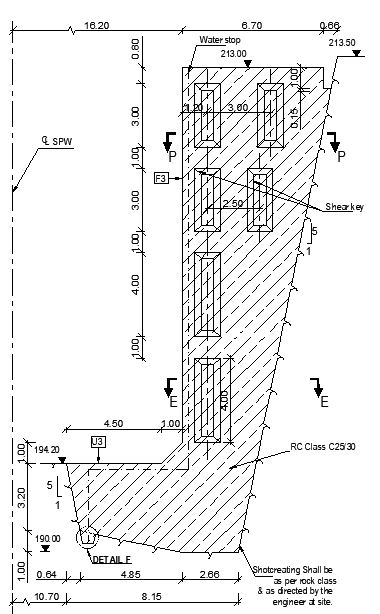
Construction joints in tunnels
In tunnel construction there are normally two construction joints. They are at both ends and directly above the sole. However, depending on construction requirements, there may be multiple construction joints in tunnels.
The Tunnel Design article discusses additional design aspects that you may find useful to read.
The construction joint in the base above is difficult to avoid. Properly threaded construction joints in combination with reinforcements can ensure sufficient strength.
Depending on the waterproofing requirements, a joint tape is provided at the construction joint.
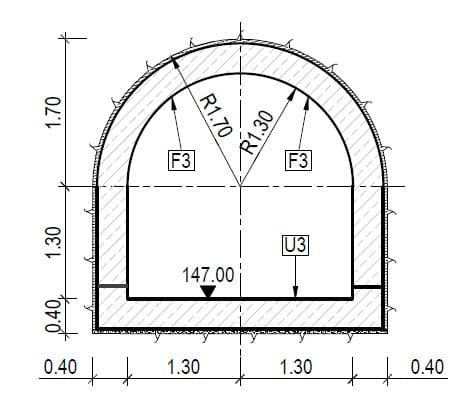
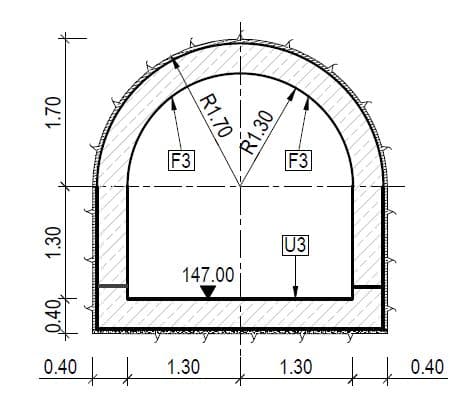
Construction joints must be waterproofed, especially if the rock cover is insufficient to stabilize the pressure that the tunnel exerts on the rock. Tunnels built for water flow and excavated in rock are subject to very high pressures at high heights.
The exit gate will be built near the end of the tunnel. Due to the slope of the rock, sometimes the thickness of the rock is not enough to guarantee stability. In such a situation, the tunnel lining needs to be reinforced to withstand the internal pressure loads.
Furthermore, construction joints in these tunnels must be sufficiently reinforced. The use of shear elements, etc. is decided based on the pressure applied. Most importantly, a joint barrier must be installed at the construction joint to prevent water leakage through the joints.
As the water leaks out, it puts pressure on the tunnel around the rock. A significant increase in pressure can lead to cracks in the rock, which in turn results in loss of the strength provided by the rock.
In addition, expansion, strength, width, etc. must be checked before installing the joint tape. Good adhesive tape should be installed on joints of this type.
Concrete joints in overflow
The construction of spillways is not common, although special techniques are used in the construction of structures of this type.
Most hydraulic structures are gravity structures with particularly high reinforcement. The high mass of concrete that is poured into the concrete guarantees the stability of the structure against gravitational loads and horizontal loads that act on it.
Due to the large amount of concrete that must be poured, structures of this type have vertical and horizontal construction joints. Even if we have a construction joint, we may need to pour the concrete with more force than normal.
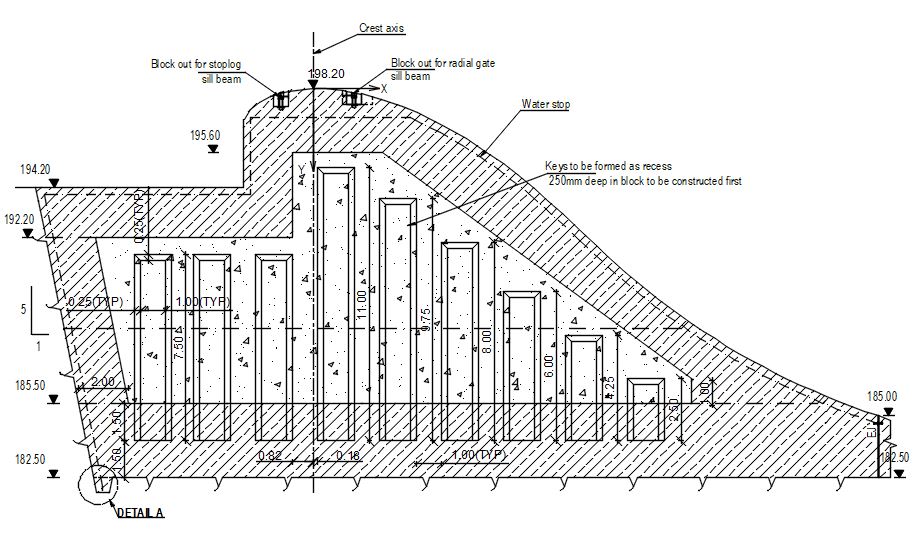
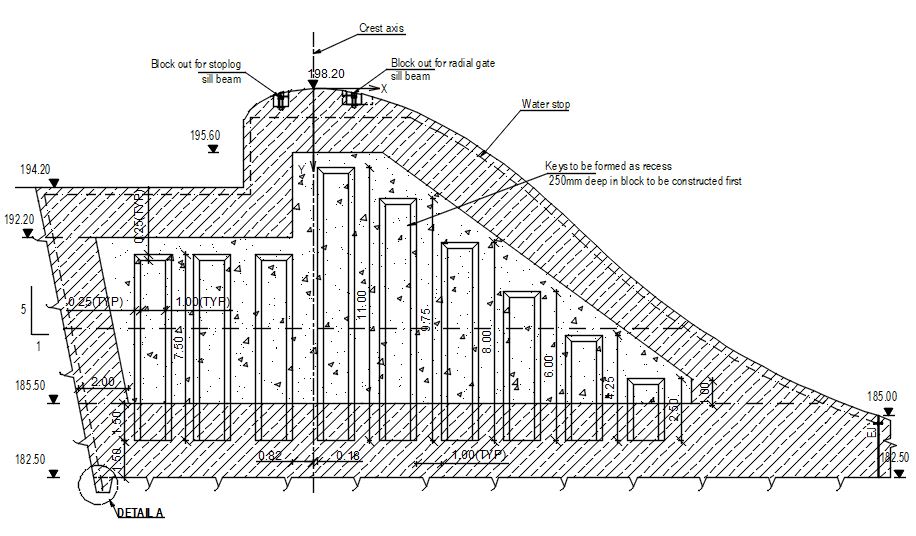
The image above shows the shear wedge pattern of a spillway profile. Due to the very high pressure that the water exerts on the channel profile, there are more shear wedges than with a single shear wedge. It also distributes lateral forces evenly across the section, rather than loading a specific area like a single shear wedge.
Furthermore, the calculation of a single shear would require a more detailed analysis of the stress distribution in the section. Internal forces can cause cracks in concrete if they are not properly identified in the design phase.
Furthermore, construction and shrinkage joints must be provided for in the construction of structures of this type.
Construction joints in slab foundations
Slab foundations are used to build different levels. Concrete occurs in several pours.
There is no point in waiting until the entire area is completed. Part by part can be concreted in different phases. In this way, the superstructure can also be completed effectively.
The smaller the area, the easier the construction. Furthermore, different teams can be used for each concreting process to speed up the work.
The type and type of construction joints of the slab foundation are more similar to those of the slab foundation.
The pin diameter can be T25 or T20. Since slab foundations are built into the ground and can be used as a ground floor slab or basement, a joint barrier is attached to the construction joint.
The rod can be placed in the middle of the shear connector. Additionally, mild steel or PVC joint tape can be used for construction.
The article appeared in Concrete Network is also worth reading.

